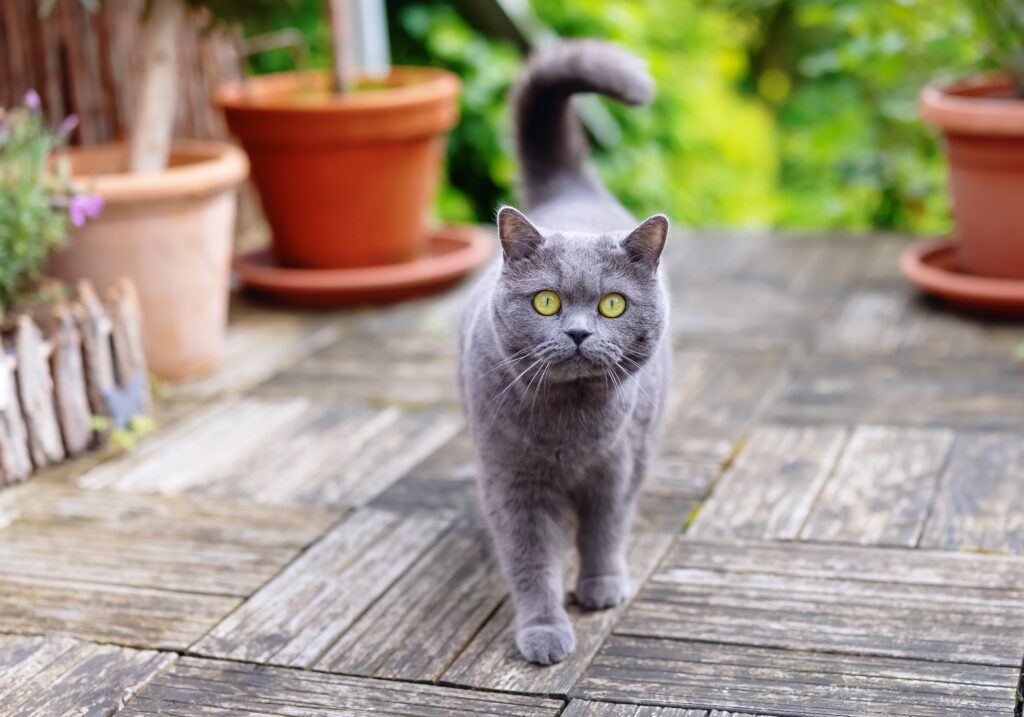The British Shorthair cat is one of the oldest cat breeds. The Romans brought their cats with them to the British Isles, where they spread and adapted to the climate. In the late 19th century, breeders exhibited these cats at Crystal Palace.
Due to small breeding stock after the world wars, breeders crossed Persian cats and domestic cats. This not only increased the diversity of the breed, but also strengthened the friendly, cuddly nature. The British Shorthair comes in over 300 recognised colour varieties.

Description and Characteristics
Generally easy-going and calm cats, they get along with everyone and are not particularly demanding. They are very adaptable and happy in both families and single households. While they can spend some time alone, it would be advisable to get a second cat if you are away from home for a long time. British Shorthair gets along well with children as long as they treat them with respect. The plush cats form a strong bond with their humans and need lots of attention and stroking. However, they do not particularly like being picked up or carried around. They tend to be among the quiet cat breeds who don’t meow much. When young, kittens are playful and curious. In old age, they prefer to spend their time lying in the sun or in a cat bed. Depending on the breeder, the external appearance of the British Shorthair can vary greatly. Generally speaking, they are a medium-sized, plump cat with short and stocky legs. They do not look clumsy, but powerful and muscular. The small, rounded ears are set wide apart and the eyes are particularly large and round. This gives this breed its typical, cute facial expression. Their short and thick tail is also characteristic. The cats are fully grown at around two years of age, with the male then weighing 6-8 kg and female around 4-6 kg.
Their solid colours include the popular blue, but also chocolate, lilac or cream, as well as black and white. Typical eye colour is copper or bright orange, although some have green or blue eyes. British Shorthair is a perfect indoor cat. Thanks to their quiet character, they are also happy in apartments, with a large scratching post as well as plenty of sleeping and playing choices. However, if you have the opportunity to offer your cat space to run around, they definitely benefit from it. A fenced garden or balcony is also suitable in case of busy roads. As one of the smartest cats, they need mental stimulation to feel comfortable. Play is also needed as the beautiful house cat can quickly become overweight. On the other hand, they need their personal retreat and extensive rest periods.
Although being a short-haired cat, the thick coat has a full undercoat. Hence you should brush the coat at least twice a week. In general, the fur is not particularly susceptible to matting and a short comb or brush is sufficient. Because of their laid-back nature, British Shorthairs require a balanced diet. Try to avoid too many treats and stick to regular feeding times.
Health and common issues
British Shorthairs are generally healthy cats. However, they can still be prone to certain health conditions. Having been bred with Persians in the past there, British Shorthairs are at higher risk of polycystic kidney disease (PKD), a disease that forms cysts in the cat’s kidney, causing organ failure. PKD can be detected through genetic testing or ultrasound and responsible breeder will screen their cats. Hypertrophic cardiomyopathy (HCM) can also be a problem in this breed. HCM causes the walls of the heart to thicken reducing the volume of blood within the heart and preventing the heart muscle from relaxing properly between contractions. There are HCM-testing schemes available, which involve genetic testing and/or regular heart scanning.






